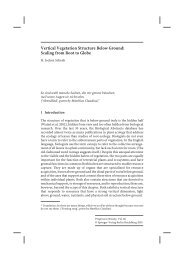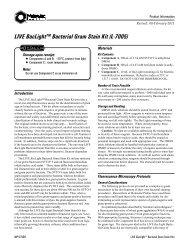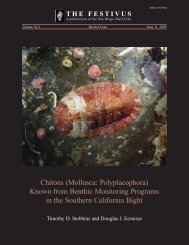Landscape Evolution at an Active Plate Margin - Biological Science ...
Landscape Evolution at an Active Plate Margin - Biological Science ...
Landscape Evolution at an Active Plate Margin - Biological Science ...
You also want an ePaper? Increase the reach of your titles
YUMPU automatically turns print PDFs into web optimized ePapers that Google loves.
ed it could be caused by assimil<strong>at</strong>ion of crustal rocks<br />
when the basaltic magma rose to shallow depth <strong>an</strong>d<br />
became gravit<strong>at</strong>ionally stable. He<strong>at</strong> from the ponded<br />
magma would melt the surrounding rocks increasing<br />
oxygen fugacity <strong>an</strong>d ch<strong>an</strong>ging the composition of the<br />
mama through assimil<strong>at</strong>ion, thus accounting for the<br />
signific<strong>an</strong>t compositional vari<strong>at</strong>ion between the various<br />
Owens Valley basalt fields.<br />
Evidence for this hypothesis comes from isotopes.<br />
Figure 1-17 is <strong>an</strong> εNd diagram for the Coso <strong>an</strong>d Big<br />
Pine fields. Coso basalts lie wholly within the m<strong>an</strong>tle<br />
array, suggesting Coso magmas were extracted from<br />
the m<strong>an</strong>tle <strong>an</strong>d extruded quickly after only limited<br />
interaction with the crust. Big Pine basalts, however,<br />
lie largely outside the m<strong>an</strong>tle array <strong>an</strong>d along <strong>an</strong><br />
evolutionary trend (Zindler <strong>an</strong>d Hart, 1986) requiring<br />
crustal contamin<strong>at</strong>ion (Zindler <strong>an</strong>d Hart, 1986).<br />
For Owens Valley basalt fields this contamin<strong>at</strong>ion<br />
occurred when ponded basaltic magma assimil<strong>at</strong>ed<br />
crustal rocks. Proceed southwest to Tinemaha Creek<br />
Campground.<br />
203.7 (0.6) Turn around <strong>at</strong> the intersection of Tinemaha<br />
Road <strong>an</strong>d Fuller Road. RETRACE to Griffith<br />
Road. Red Mountain is the large volc<strong>an</strong>ic cone to the<br />
west-southwest <strong>an</strong>d the cinder cone of Cr<strong>at</strong>er Mountain<br />
is to the north.<br />
205.3 (1.6) TURN LEFT on Griffith Road from Tinemaha<br />
Road. The view northwest <strong>at</strong> 10:00 is of a small<br />
red cinder cone with black basalt flows from Cr<strong>at</strong>er<br />
Mountain (elev. 6055’) to the northwest.<br />
205.7 (0.4) Join Fish Springs Road. Proceed north.<br />
The scarp of the Inyo/Owens/Fish Creek fault <strong>at</strong> the<br />
base of Cr<strong>at</strong>er Mountain is <strong>at</strong> 10:00.<br />
207.0 (1.3) Fish Springs h<strong>at</strong>chery on the left is the<br />
largest in Owens Valley.<br />
207.6 (0.6) PULL TO THE RIGHT <strong>an</strong>d PARK.<br />
STOP 1-8. Fish Springs Fault Scarp. Two scarps<br />
are exposed along the east face of Cr<strong>at</strong>er Mountain.<br />
Looking to the west, the Owens Valley fault (OVF)<br />
scarp is visible as <strong>an</strong> east-facing scarp. This part of the<br />
fault defines a 12 mile long segment of the OVF extending<br />
from the northwest side of the Poverty Hills<br />
to a termin<strong>at</strong>ion north of Big Pine <strong>an</strong>d referred to as<br />
the Big Pine segment. Almost due west of the stop is<br />
a tephra cone th<strong>at</strong> is cut on its west side by the fault.<br />
Following with the eye northward from the cone, the<br />
scarp is first seen to cut alluvial f<strong>an</strong> m<strong>at</strong>erial <strong>an</strong>d then<br />
to cut basalt of Cr<strong>at</strong>er Mountain. The scarp cuts west<br />
D. R. Jessey <strong>an</strong>d R. E. Reynolds<br />
of a hill composed of basalt just north of the alluvial<br />
f<strong>an</strong> m<strong>at</strong>erials. Another scarp is developed on the east<br />
side of the hill. On the north side of the hill, the faults<br />
on either side of the hill merge. The portion of the Big<br />
Pine fault segment between the Poverty Hills <strong>an</strong>d the<br />
point where the two faults merge is referred to as the<br />
Fish Springs fault.<br />
From study of the tephra cone offset, Martel (1989)<br />
demonstr<strong>at</strong>ed th<strong>at</strong> the Fish Springs fault is <strong>an</strong> eastside<br />
down dip slip fault with no strike-slip component.<br />
This poses a problem to the tr<strong>an</strong>spressional<br />
uplift model for the Poverty Hills. Without a rightl<strong>at</strong>eral<br />
component of slip on the Fish Springs fault,<br />
there is no geometric reason for uplift of the western<br />
Poverty Hills.<br />
Be<strong>an</strong>l<strong>an</strong>d <strong>an</strong>d Clark (1994) proposed th<strong>at</strong> the Big<br />
Pine segment contains a large strike-slip component<br />
north of the Fish Springs fault. As evidence, they<br />
listed the possible right-l<strong>at</strong>eral offset of two hills along<br />
the fault <strong>at</strong> Cr<strong>at</strong>er Mountain, offset of a line of tree<br />
stumps near Big Pine, <strong>an</strong>d offset of a stream ch<strong>an</strong>nel<br />
north of Big Pine. Examin<strong>at</strong>ion of each of these fe<strong>at</strong>ures<br />
suggests th<strong>at</strong> the evidence is weak. The possible<br />
offset of the hills is questioned because it is not clear<br />
how the hills formed. They are localized in <strong>an</strong> unusual<br />
area of the fault, where the fault contains a graben<br />
structure. Until the origin of the hills is understood,<br />
it is arguable th<strong>at</strong> the hills have been offset horizontally.<br />
The line of tree stumps is irregular <strong>an</strong>d it is not<br />
clear the trees were not pl<strong>an</strong>ted in a p<strong>at</strong>tern th<strong>at</strong> today<br />
suggests the possibility of right l<strong>at</strong>eral offset. Furthermore,<br />
it is not even clear th<strong>at</strong> the trees pre-d<strong>at</strong>e<br />
the most recent fault rupture. Finally, it is not clear<br />
th<strong>at</strong> the proposed offset stream ch<strong>an</strong>nels were ever<br />
directly adjacent to <strong>an</strong>other.<br />
In order to explain the lack of a strike-slip displacement<br />
on the Fish Springs fault, they suggested th<strong>at</strong><br />
strike-slip motion <strong>an</strong>d dip-slip motion is partitioned<br />
<strong>at</strong> the l<strong>at</strong>itude of the Fish Springs fault with dip-slip<br />
movement occurring on the Fish Springs fault <strong>an</strong>d<br />
strike-slip movement occurring on the eastern fault.<br />
This suggestion is specul<strong>at</strong>ive in th<strong>at</strong> there is no<br />
evidence for strike-slip displacement on the eastern<br />
fault. As <strong>an</strong> altern<strong>at</strong>ive in light of the weak evidence<br />
for strike-slip displacement on the Big Pine segment<br />
it is proposed th<strong>at</strong> the entire Big Pine segment is a<br />
pure dip slip fault. We will consider evidence for this<br />
possibility <strong>at</strong> the next stop. Return to vehicles. Proceed<br />
north.<br />
26 2009 Desert Symposium
















